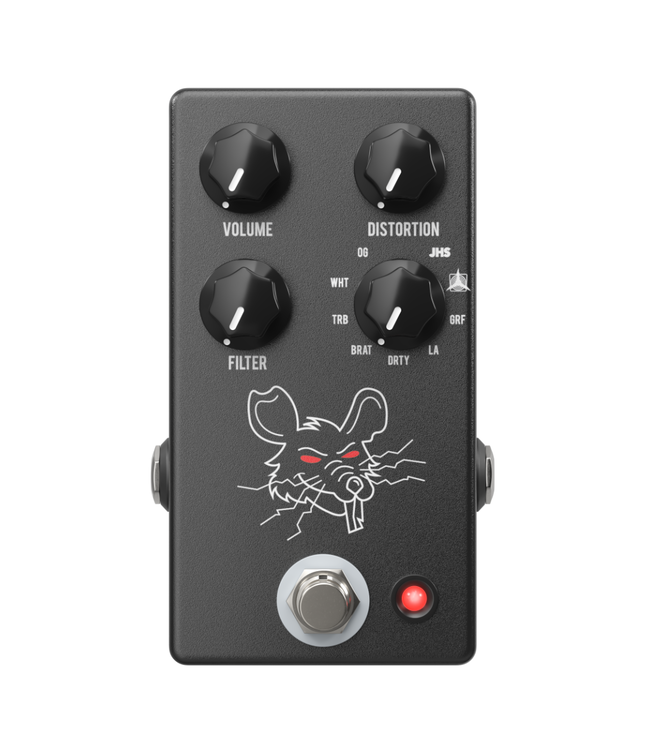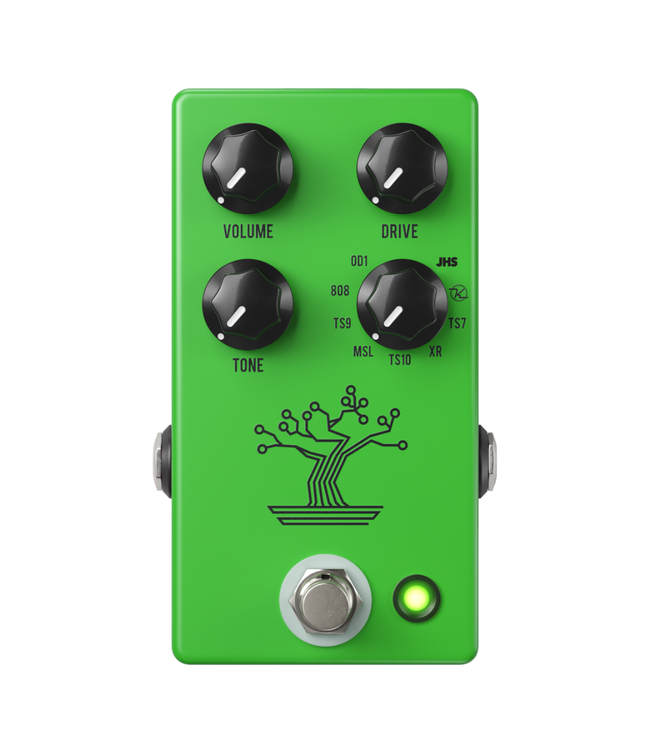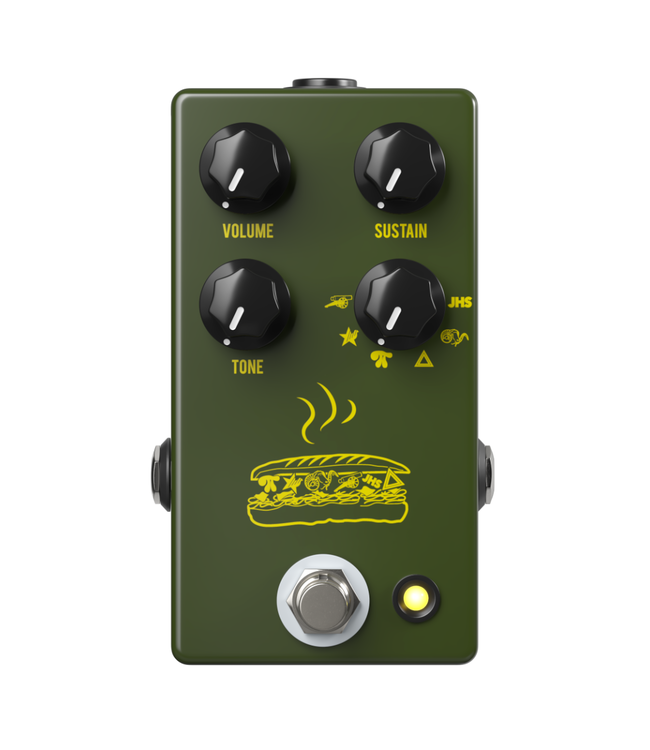9-Way RAT Distortion Read more..
Price Matching
Find a lower price? We'll match it!Financing Available
Flexible payment options at checkout.In-Store Pickup
Local pickup available in Milton, ON.Customer Service
Have a question? Use our online chat.
Product description
The PackRat is the ultimate tribute to the 40+ years of rodent evolution and its impact on the guitar's sound. Artists from every genre have used the iconic tones in this unassuming black box to create their sounds, including Nirvana, John Scofield, Pink Floyd, Metallica, REM, the Eagles, Jeff Beck and Radiohead.
Building on JHS' Multi-Mode pedal series that includes the Muffuletta and Bonsai, the PackRat uses the same unique digital runway system to direct the paths of 261 components through 40 individual switches. This means that when you choose one of the nine legendary or rare modes, you are playing fully analog circuits that perfectly replicate that mode, even down to the aging components (also known as component drift).
Controls
The operation of the PackRat is about as simple as it gets. The "Volume" control adjusts the overall volume of the pedal. The "Distortion" control lets you raise and lower the amount of gain or distortion that the circuit produces, and the "Filter" control allows you to brighten and darken the sound of the overall effect. This is effectively a simple, low-pass filter. Lastly, "Mode" control. This is a stepped pot that clicks into place as you scroll through the nine legendary versions of this circuit. As you change the mode, the analog circuitry is rewired, resulting in brand new values of resistors, capacitors, diodes and op amps.
The PackRat Modes:
- The OG (1979-83) - The OG mode is a perfect recreation of the first production RATs ever made. This era of roughly four years covers what is referred to historically as the V1 and V2 models. When switching to the OG mode, you are activating the exact circuitry of a 1979 V1 model, including the accurate "Tone" control rotation and taper. The V1 and V2 models are the exact same circuit, and simple adjustments to the "Tone/Filter" control can achieve identical sounds from each unit.
- White Face V3 (1984-1986) - The "White Face" model gained a reputation as one of the holy grail RATs, and it even spawned a reissue in the nineties. The irony is that it is the same exact circuit as the previous "Big Box" V2 and the following "non-white logo" 1986 V4, as well as the 1988 V5 "LED Version." The "White Face" V3 update was purely cosmetic (some V2s and V3s share the exact same circuit board). ProCo knew that the world wanted smaller pedals in the wake of brands like BOSS, DOD and Ibanez gaining more and more market share, and they wisely cashed in on the trend.
- Turbo V6 (1989) - The heart of the RAT's tone comes from a design technique called "Symmetrical Hard Clipping." In this approach, a simple amplifier circuit amplifies the guitar's signal and pushes it across a pair of clipping diodes. The result is that these diodes clip off the top of the waveform of the guitar and create a type of square wave distortion. Every RAT until 1989 utilized a typical silicon diode, just like the DOD 250 and BOSS DS-1, but the new Turbo RAT used LEDs (Light Emitting Diodes). The Turbo's LEDs have a much higher forward voltage, so they don't activate or clip the signal as fast or as hard. It takes more signal to reach the point where they will "cut off" the waveform, which causes the phenomenon known as "Touch Sensitivity." You can set the Distortion lower, and as you play lightly, you will have an overdrive tone; dig into your guitar and play hard, and hear more clipping/distortion.
- BRAT (1997) - The BRAT added an input buffer circuit and soft clipping (inside the loop of the op amp) on top of the standard hard clipping of the previous RATs. A return to the opposite taper/rotation "Filter" control and several capacitor value changes that alter the frequency response and characteristics of the distortion.
- Dirty (2004) - This pedal allowed you to have two completely separate RATs and activate them independently or stack them together. It also introduced two brand new sounds into the RAT topology: "Clean RAT" mode and "Dirty RAT." Due to the popularity of the "Dirty RAT" mode, they released a single pedal called "You Dirty RAT" that featured that single setting in a standard sloped RAT enclosure. This circuit utilizes germanium diodes in the symmetrical hard clipping section of the circuit. This technique gives the most saturation and waveform clip-off of any version ever made. In addition to the diode changes, this model has several different capacitor value changes resulting in a different distortion character and feel.
- LA (1986) - In 1986, Ibanez released the "10 Series" line of pedals that included three RAT style pedals. The "Super Product" and "Fat Cat" held the position of accurate and traditional RAT style pedals, while the quirkier "LA Metal" was one of the best-modified RAT circuits of the eighties. It includes a great input buffer, several key capacitor changes for frequency response, and no clipping diodes at all. The distortion is produced by overloading or "clipping the rails" of the op amp.
- Landgraff MO'D (1999) - Between 1999-2000, a man named John Landgraff started building pedals by hand in Pensacola, FL. Each one painted with a unique swirl paint job and wired point to point; John's pedals were and still are the true definition of boutique and gained a reputation for sounding amazing. His most popular pedal was the Landgraff Dynamic Overdrive, a take on the Ibanez Tubescreamer.
- Caroline (2010) - Based on work in conjunction with Philippe Herndon, this mode was inspired by the Wave Cannon pedal that started the PackRat project.
- JHS Mode - Starting as a modded vintage "small-box" RAT, parts of that modification became the now discontinued JHS All American and the long-running JHS PackRat modification that was performed on thousands of RAT pedals from 2008-2018. The JHS Mode lets you keep what makes the RAT unique and adds in a few personalized mods.
Specifications
JHS PackRat Distortion Pedal
0 reviewsReview JHS JHS PackRat Distortion Pedal
9-Way RAT Distortion

















